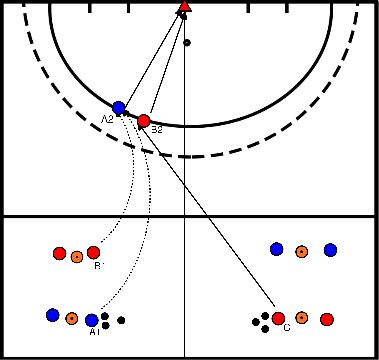Hockey drills for technique dribbling
Three-color game
- Players all have a ball and dribble through the box of pawns.
- Scattered through the box are pawns of three different colors; at least 4 of each color.
- Trainer has in hand of all three colors -i.e. in the example red, blue and white.
- Trainer puts e.g. a blue pawn in the air --> All players try to drive around all blue pawns as quickly as possible.
- The first two players who have driven around all blue pawns get a point.
- Then a new round begins and the trainer chooses another color pawn -or the same color.
- Etc.
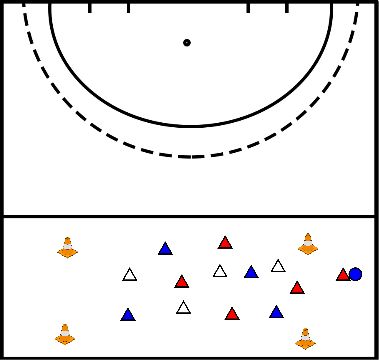
Relay
- As trainers, create two equal teams.
- Start the relay at the trainer's signal.
- The players slalom around the pawns. Both ball and body around the pawns. And rounds on goal; push or flatten.
- If the player scores, he may immediately sprint back and tap the next player.
- If the player misses, he must take a detour via the blue pawn at the side of the field and then sprint back and tap the next player.
- When it's your turn, you sit on the floor.
- Depending on the number of players, you can also choose to have all players take 2 or 3 turns.
- The next player may not start until he is tapped by the player in front of him.
- The team that has all players on the ground first wins the relay.
- There are different types of slalom to apply in this exercise:
- Normal slalom
- Slalom in which the player's body and ball are to the left or right of the pawn line
- Slalom where the ball is to the left of the row of pawns and the body is to the right
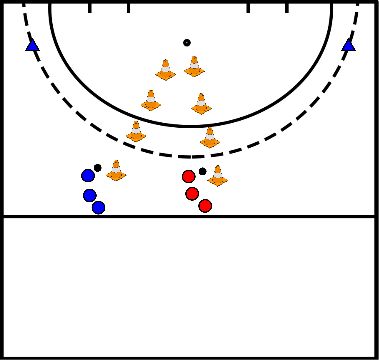
- The trainer makes two equal teams and divides them into two rows.
- The first player on each team starts with a slalom around the green pawns.
- Then he drives a lap around the blue pawns -right around.
- He puts the ball on the orange pawn and sprints back to the row of players.
- There he taps the next player.
- This one does exactly the same thing only without ball and stick.
- He picks up the ball from the cone and sprints back to the row.
- There he puts the ball ready for the next player, who travels the route again with ball and stick, and so on.
- The team that first, has all its players finish twice, is the winner of the game.
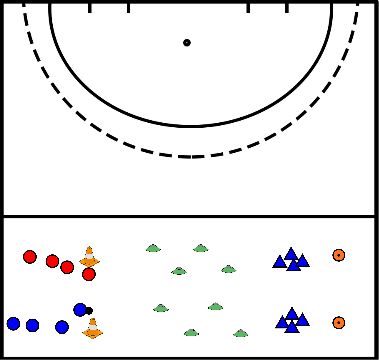
1 vs. 1
- The trainer sets out a square and gathers all the balls and players in it.
- The trainer gives all players a number. In this example, 1 through 6.
- The trainer calls out two numbers each time. In this example 3 and 5.
- The player with number 3 plays a 1 vs. 1 against the player with number 5.
- The player who scores a goal gets a point.
- Then the coach calls two other numbers, after which a new 1 vs. 1 is played.
- The players keep track of how many points they have made.

Overrun
- All but one player start with ball on the line.
- They try to reach the other side of the field without losing the ball.
- The defender -player red- tries to take the ball from the players -blue- and work it out of the box.
- If a player loses his ball and the ball is played out of the box then he is finished.
- He then helps the defender to take the balls off and work them out of the box.
- The game continues until all players are finished.
- The player last left wins the game.
Points of Attention:
- Is the game finished, start over with another defender.
- If the player commits a foul, he is also finished.
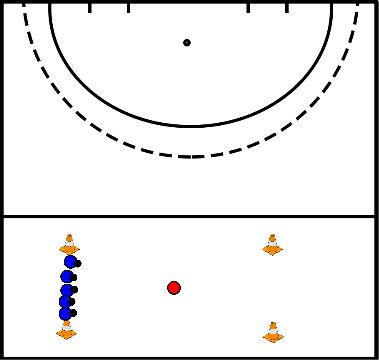
Superslalom.
You can perform this slalom in 4 different ways:
You can perform this slalom in 4 different ways:
- Normal slalom: player and ball move forward through the gates.
- Player keeps moving to the left of the gates and has the ball on the right side of his body.
- Player continues to move to the right of the gates and has the ball on the left side of his body.
- Player moves to the left of the first gate and ball passes on the right, player moves to the right of the second gate and ball passes on the right. The player continues to alternate this until the end of the slalom.
After the slalom, the player rounds the ball on goal and rejoins the back of the line.
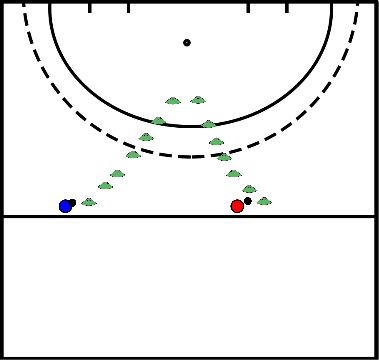
Dummy:
- The player does three passes behind the dummy and rounds on target.
- You can also do this exercise in relay form (do emphasize the proper execution of the exercise and not the speed).
Points of attention:
- With the dummy, it is important that you pretend to pass to the left, but eventually accelerate right around the pawn.
- Make sure you step out well with your left foot and pass the ball well under you.
- After your move, accelerate briefly to the next double pawn.
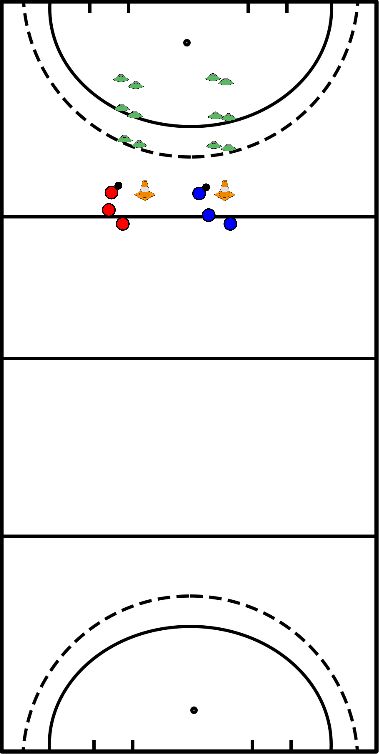
Relay
- Create two equal teams.
- Start the relay at the coach's signal.
- The player slaloms around the pawns -both ball and body around the pawns- and rounds on goal -push or flush-.
- If the player scores, he may immediately sprint back and tap the next player.
- If the player misses, he must take a detour via the blue pawn -on the side of the field- and then sprint back and tap the next player.
- When it's your turn, you sit down on the ground.
- Depending on the number of players, you can also choose to have all players take 2 or 3 turns.
- The next player may not start until he is tapped by the player in front of him.
- The team that has all players on the ground first wins the relay.
- There are different types of slalom to apply in this exercise:
- Normal slalom
- Slalom in which the player's body and ball are to the left or right of the row of pawns.
- Slalom where the ball is to the left of the row of pawns and the body is to the right.
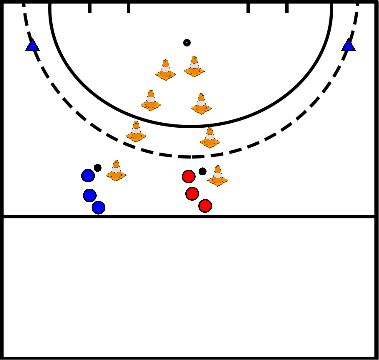
- Ben in the al float and passes out of the run.
- Ball back on takeover run and round off on goal.
- Player A runs with the ball passes to player B, gets the ball back and rounds on goal.
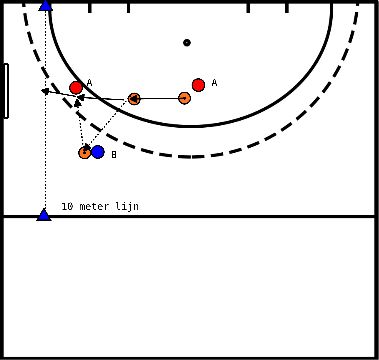
- There are 4 pawns in a diamond, and 1 in the middle.
- The balls start at 2 pawns opposite each other.
- Then walk to the center and pass it to the right.
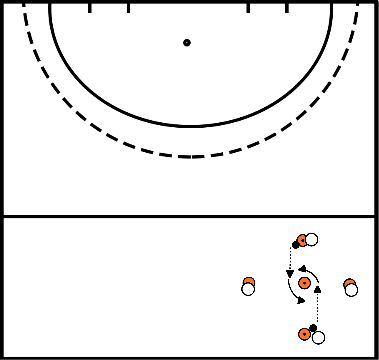
- Ball starts with player 1, who runs to the back line, turns close and passes the ball in the run to player 2.
- Player two runs towards the 23, makes a turn to the right and pushes the ball to player 3.
- Player 3 attempts to run towards header circle but retrieves the ball at the ion and passes to player 4.
- Player 4 runs towards the back line and passes the ball towards head circle.
- Player 3 has run on after the pass and has taken position between the head circle and the center spot and will choose from here between rounding or playing on the tip.
- Player 1 is ready for the tip.
- Direction of rotation in chronological order.
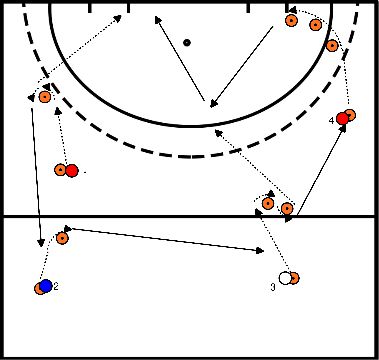
- Exercise B+C
- B is about the left
- C is over the right
- A1 dribbles with ball to A2
- B guides player A, at 1,5 meter, backwards (open position).
- This is about footwork, so when A arrives at A2 he just lets A strike at goal.
- After the hit, A leaves the circle. B turns around and gets a ball from C. B takes a closed approach, turns open and plays the ball.
- B takes a closed approach, turns open and rounds the goal.
- Then the exercise starts on the right.
